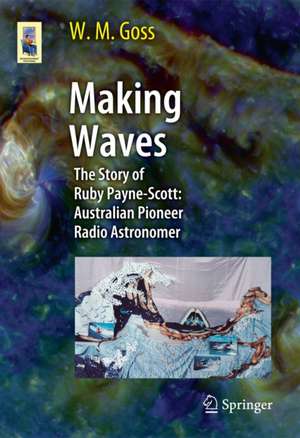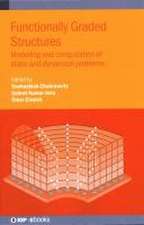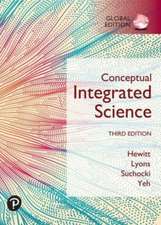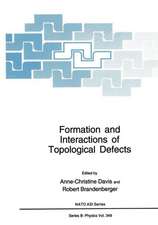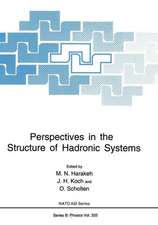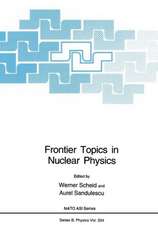Making Waves: The Story of Ruby Payne-Scott: Australian Pioneer Radio Astronomer: Astronomers' Universe
Autor M Gossen Limba Engleză Paperback – 29 iul 2013
She also played a major role in the design of the Australian government's Council for Scientific and Industrial Research radars, which were in turn of vital importance in the Southwest Pacific Theatre in World War II. These radars were used by military personnel from Australia, the United States and New Zealand. From a sociological perspective, her career offers many examples of the perils of being a female academic in the first half of the 20th century.
Written in an engaging style and complemented by many historical photographs, this book offers fascinating insights into the beginnings of radio astronomy and the role of a pioneering woman in astronomy. To set the scene, the first colourfully illustrated chapter presents an overview of solar astrophysics and the tools of the radio astronomer.
From the reviews of “Under the Radar”:
“This is a beautifully-researched, copiously-illustrated and well-written book that tells us much more than the life of one amazing female radio astronomer. It also provides a profile on radar developments during WWII and on Australia’s pre-eminent place in solar radio astronomy in the years following WWII. Under the Radar is compelling reading, and if you have taken the time to read right through this review then it certainly belongs on your bookshelf!” (Wayne Orchiston, Journal of Astronomical History and Heritage, March, 2010)
Din seria Astronomers' Universe
-
 Preț: 210.44 lei
Preț: 210.44 lei -
 Preț: 207.15 lei
Preț: 207.15 lei -
 Preț: 195.53 lei
Preț: 195.53 lei -
 Preț: 254.90 lei
Preț: 254.90 lei -
 Preț: 259.27 lei
Preț: 259.27 lei -
 Preț: 212.88 lei
Preț: 212.88 lei -
 Preț: 256.41 lei
Preț: 256.41 lei -
 Preț: 264.35 lei
Preț: 264.35 lei -
 Preț: 259.08 lei
Preț: 259.08 lei -
 Preț: 227.61 lei
Preț: 227.61 lei -
 Preț: 277.98 lei
Preț: 277.98 lei -
 Preț: 305.70 lei
Preț: 305.70 lei -
 Preț: 253.11 lei
Preț: 253.11 lei -
 Preț: 216.60 lei
Preț: 216.60 lei -
 Preț: 272.24 lei
Preț: 272.24 lei -
 Preț: 330.75 lei
Preț: 330.75 lei -
 Preț: 179.00 lei
Preț: 179.00 lei -
 Preț: 289.83 lei
Preț: 289.83 lei -
 Preț: 160.03 lei
Preț: 160.03 lei -
 Preț: 200.80 lei
Preț: 200.80 lei -
 Preț: 255.97 lei
Preț: 255.97 lei -
 Preț: 242.58 lei
Preț: 242.58 lei -
 Preț: 262.55 lei
Preț: 262.55 lei -
 Preț: 257.08 lei
Preț: 257.08 lei -
 Preț: 187.82 lei
Preț: 187.82 lei -
 Preț: 225.19 lei
Preț: 225.19 lei -
 Preț: 207.64 lei
Preț: 207.64 lei -
 Preț: 188.94 lei
Preț: 188.94 lei -
 Preț: 270.49 lei
Preț: 270.49 lei -
 Preț: 212.01 lei
Preț: 212.01 lei -
 Preț: 169.08 lei
Preț: 169.08 lei -
 Preț: 210.01 lei
Preț: 210.01 lei -
 Preț: 208.26 lei
Preț: 208.26 lei -
 Preț: 253.98 lei
Preț: 253.98 lei -
 Preț: 180.12 lei
Preț: 180.12 lei -
 Preț: 254.90 lei
Preț: 254.90 lei -
 Preț: 247.82 lei
Preț: 247.82 lei -
 Preț: 207.39 lei
Preț: 207.39 lei -
 Preț: 208.70 lei
Preț: 208.70 lei -
 Preț: 214.86 lei
Preț: 214.86 lei -
 Preț: 188.94 lei
Preț: 188.94 lei -
 Preț: 194.65 lei
Preț: 194.65 lei -
 Preț: 277.34 lei
Preț: 277.34 lei -
 Preț: 187.15 lei
Preț: 187.15 lei -
 Preț: 210.93 lei
Preț: 210.93 lei -
 Preț: 212.01 lei
Preț: 212.01 lei
Preț: 104.35 lei
Nou
Puncte Express: 157
Preț estimativ în valută:
19.97€ • 20.60$ • 16.90£
19.97€ • 20.60$ • 16.90£
Carte disponibilă
Livrare economică 12-26 februarie
Livrare express 28 ianuarie-01 februarie pentru 33.17 lei
Preluare comenzi: 021 569.72.76
Specificații
ISBN-13: 9783642357510
ISBN-10: 3642357512
Pagini: 300
Ilustrații: XX, 262 p. 87 illus., 27 illus. in color.
Dimensiuni: 155 x 235 x 17 mm
Greutate: 0.41 kg
Ediția:2013
Editura: Springer Berlin, Heidelberg
Colecția Springer
Seria Astronomers' Universe
Locul publicării:Berlin, Heidelberg, Germany
ISBN-10: 3642357512
Pagini: 300
Ilustrații: XX, 262 p. 87 illus., 27 illus. in color.
Dimensiuni: 155 x 235 x 17 mm
Greutate: 0.41 kg
Ediția:2013
Editura: Springer Berlin, Heidelberg
Colecția Springer
Seria Astronomers' Universe
Locul publicării:Berlin, Heidelberg, Germany
Public țintă
Popular/generalCuprins
A Brief, Basic Guide to Terms and Concepts of Solar Radio Astronomy.- Ruby Payne-Scott’s Ancestors and Her Early Childhood.- Ruby Payne-Scott’s Education and Early Employment.- Wartime Research by Ruby Payne-Scott at the Radiophysics Laboratory.- 1944-1945: Ruby Payne-Scott – The First Woman Radio Astronomer.- 1945-1946: Early Radio Astronomy at Dover Heights.- 1946-1947: Personal Tragedy and Professional Triumph.- 1948: Hornsby Field Station – Daily Observations.- 1949-1951: Radio Astronomy Blossoms as a Field, but Ruby Must Resign from the Radiophysics Laboratory.- 1952: Ruby Payne-Scott’s Last Experience as a Radio Astronomer at the International Union of Radio Science.- The Married Life and Motherhood of Ruby Payne-Scott.- 1963-1974: Employment at Danebank School.- The Last Years and Legacy of Ruby Payne-Scott.
Recenzii
From the reviews:
“This book documents the history of the early days of radar astronomy in Australia and the scientific career of Ruby Payne-Scott. … For everyone else, I recommend reading Making Waves … . Printed in paperback, and with colour pictures, the book even looks easier to read.” (Kate Brooks, Historical Records of Australian Science, Vol. 25 (1), 2014)
“This book documents the history of the early days of radar astronomy in Australia and the scientific career of Ruby Payne-Scott. … For everyone else, I recommend reading Making Waves … . Printed in paperback, and with colour pictures, the book even looks easier to read.” (Kate Brooks, Historical Records of Australian Science, Vol. 25 (1), 2014)
Notă biografică
Miller Goss received his undergraduate degree in astronomy from Harvard in 1963 and a PhD from the University of California (Berkeley) in 1967, working on the newly discovered OH radio frequency line at the Hat Creek Observatory. He then moved to Australia to the CSIRO Division of Radiophysics, first as a postdoctoral fellow and later as a staff member. In 1976 he was the recipient of the Pawsey Medal of the Australian Academy of Science. From 1977 to 1986 he was on the staff of the Kapteyn Astronomical Institute of the University of Groningen, the Netherlands, and then professor from 1980 to 1986. In 1986 he moved to the National Radio Astronomy Observatory (NRAO) in Socorro New Mexico (USA). He was Director of the Very Large Array and the Very Long Baseline Array from 1988 to 2002. He and Dick McGee began working on Under the Radar, the First Woman in Radio Astronomy: Ruby Payne-Scott, in 1997. It was published in 2009 with book launches in Sydney and Canberra. At present Goss and Claire Hooker are working on a joint biography of J.L. Pawsey and J.G. Bolton. Goss’ scientific interests are radio astronomical studies of the interstellar medium in the Milky Way and nearby galaxies. Goss is currently on the scientific staff of NRAO and is the author of over 500 astronomical publications.
Under the Radar, the First Woman in Radio Astronomy: Ruby Payne-Scott, in 1997. It was published in 2009 with book launches in Sydney and Canberra. At present Goss and Claire Hooker are working on a joint biography of J.L. Pawsey and J.G. Bolton. Goss’ scientific interests are radio astronomical studies of the interstellar medium in the Milky Way and nearby galaxies. Goss is currently on the scientific staff of NRAO and is the author of over 500 astronomical publications.
Under the Radar, the First Woman in Radio Astronomy: Ruby Payne-Scott, in 1997. It was published in 2009 with book launches in Sydney and Canberra. At present Goss and Claire Hooker are working on a joint biography of J.L. Pawsey and J.G. Bolton. Goss’ scientific interests are radio astronomical studies of the interstellar medium in the Milky Way and nearby galaxies. Goss is currently on the scientific staff of NRAO and is the author of over 500 astronomical publications.
Textul de pe ultima copertă
This book is an abbreviated, partly re-written version of "Under the Radar - The First Woman in Radio Astronomy: Ruby Payne-Scott." It addresses a general readership interested in historical and sociological aspects of astronomy and presents the biography of Ruby Payne-Scott (1912 – 1981). As the first female radio astronomer (and one of the first people in the world to consider radio astronomy), she made classic contributions to solar radio physics.
She also played a major role in the design of the Australian government's Council for Scientific and Industrial Research radars, which were in turn of vital importance in the Southwest Pacific Theatre in World War II. These radars were used by military personnel from Australia, the United States and New Zealand. From a sociological perspective, her career offers many examples of the perils of being a female academic in the first half of the 20th century.
Written in an engaging style and complemented by many historical photographs, this book offers fascinating insights into the beginnings of radio astronomy and the role of a pioneering woman in astronomy. To set the scene, the first colourfully illustrated chapter presents an overview of solar astrophysics and the tools of the radio astronomer.
From the reviews of “Under the Radar”:
“This is a beautifully-researched, copiously-illustrated and well-written book that tells us much more than the life of one amazing female radio astronomer. It also provides a profile on radar developments during WWII and on Australia’s pre-eminent place in solar radio astronomy in the years following WWII. Under the Radar is compelling reading, and if you have taken the time to read right through this review then it certainly belongs on your bookshelf!” (Wayne Orchiston, Journal of Astronomical History and Heritage, March, 2010)
She also played a major role in the design of the Australian government's Council for Scientific and Industrial Research radars, which were in turn of vital importance in the Southwest Pacific Theatre in World War II. These radars were used by military personnel from Australia, the United States and New Zealand. From a sociological perspective, her career offers many examples of the perils of being a female academic in the first half of the 20th century.
Written in an engaging style and complemented by many historical photographs, this book offers fascinating insights into the beginnings of radio astronomy and the role of a pioneering woman in astronomy. To set the scene, the first colourfully illustrated chapter presents an overview of solar astrophysics and the tools of the radio astronomer.
From the reviews of “Under the Radar”:
“This is a beautifully-researched, copiously-illustrated and well-written book that tells us much more than the life of one amazing female radio astronomer. It also provides a profile on radar developments during WWII and on Australia’s pre-eminent place in solar radio astronomy in the years following WWII. Under the Radar is compelling reading, and if you have taken the time to read right through this review then it certainly belongs on your bookshelf!” (Wayne Orchiston, Journal of Astronomical History and Heritage, March, 2010)
Caracteristici
Presents the popular science version of a book that received gleaming reviews in the press and by historians of astronomy Gives insight into the pioneering contributions of a female scientist at the beginning of radio astronomy Provides a critical view on the role of women in science in the first half of the 20th century Illustrates Australia's important contribution to the onset of radio astronomy as a new window of research in the electromagnetic spectrum With an overview of Solar Astrophysics and the Tools of the Radio Astronomer, illustrated with many colourful photos Includes supplementary material: sn.pub/extras
